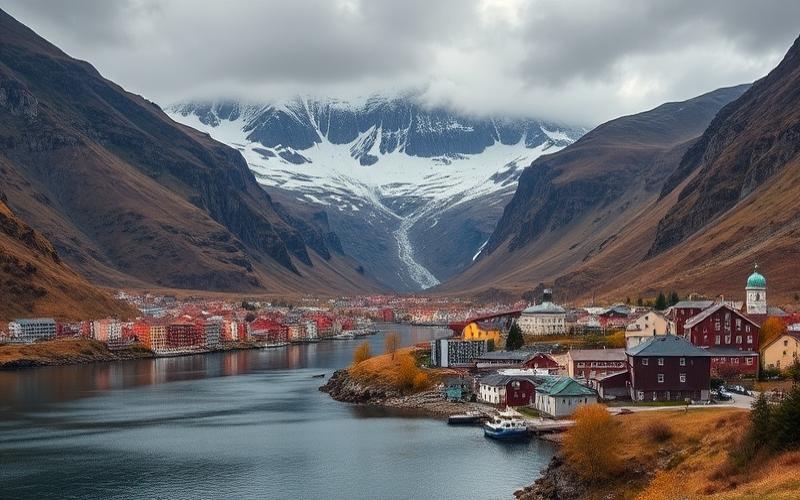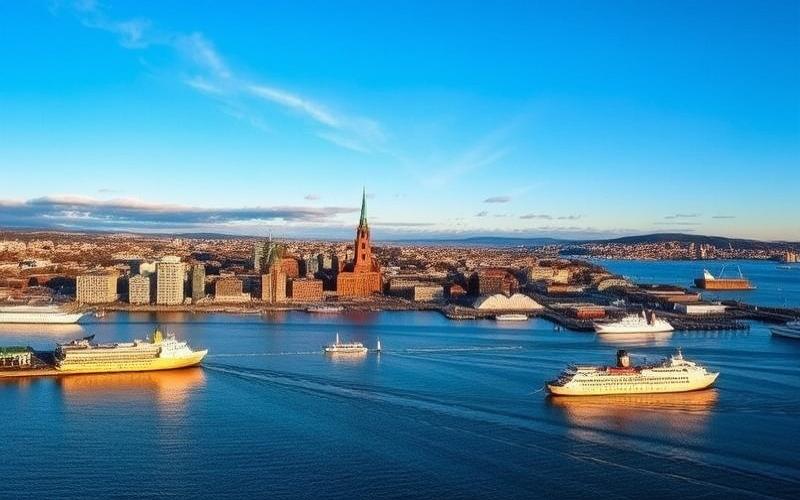
 Published on and written by Cyril Jarnias
Published on and written by Cyril Jarnias
Commercial real estate in Norway offers particularly attractive investment opportunities for savvy investors. As a Scandinavian country renowned for its economic and political stability, Norway boasts a dynamic and diversified real estate market that is attracting increasing numbers of foreign investors. In this article, we will explore in detail the various aspects of investing in Norwegian commercial real estate, from the types of properties available to current sector trends, including potential returns and risks to consider.
A Range of Commercial Properties for All Investor Profiles
The Norwegian commercial real estate market is characterized by a great diversity of assets, thus offering opportunities suited to different investor profiles and investment strategies. Among the main types of commercial properties available are:
Office Buildings: Demand for modern, well-located office spaces remains strong in major Norwegian cities, particularly in Oslo, Bergen, and Trondheim. These properties often attract quality tenants, such as international companies or government institutions, thereby offering stable long-term rental income.
Shopping Centers and Retail Spaces: Despite increasing competition from e-commerce, well-located shopping centers and retail spaces in urban areas continue to attract investors. Norway has high purchasing power and a well-established consumer culture, which supports the demand for quality commercial spaces.
Warehouses and Logistics: With the rise of online commerce and the growing need to optimize supply chains, logistics properties are experiencing renewed interest. Areas located near major transport routes and main urban centers are particularly sought after.
Hospitality Real Estate: The tourism sector in Norway, although seasonal, offers interesting opportunities, particularly in the picturesque fjord regions or in major cities that attract business and leisure tourism year-round.
Industrial Properties: Industrial zones, especially those linked to the oil and gas sector, also constitute potential investment targets, although they are more specialized and subject to fluctuations in the energy market.
Good to Know:
The diversity of the Norwegian commercial real estate market allows investors to build a balanced portfolio and spread risks across different property types and geographic areas.
Attractive Profitability and Risk Management: Finding the Right Balance
Investing in commercial real estate in Norway can offer attractive returns, but it is essential to understand the factors that influence profitability and the associated risks.
Competitive Returns: Historically, Norwegian commercial real estate has offered stable and attractive returns compared to other asset classes. Yield rates generally range between 3.5% and 7% depending on the property type and location. Prime office buildings in Oslo can offer yields around 3.5-4%, while logistics properties or shopping centers on the outskirts can achieve yields above 6%.
Economic and Political Stability: Norway benefits from a strong economy, supported by its natural resources (oil, gas, fishing) and prudent management of public finances. This stability is reflected in the real estate market, which has shown remarkable resilience in the face of global economic crises.
Transparency and Favorable Legal Framework: The Norwegian real estate market is renowned for its transparency and clear regulatory framework, which facilitates transactions and reduces risks for foreign investors. Property rights are well protected by law.
Risks to Consider: Despite these advantages, there are risks to consider:
- The volatility of the oil market can impact the Norwegian economy and, by extension, the real estate market.
- Fluctuations in the Norwegian krone can affect returns for foreign investors.
- Increased competition for quality assets in major cities can put downward pressure on yields.
- Regulatory changes, particularly in urban planning or taxation, can influence investment profitability.
Risk Management Strategies: To optimize the risk/return ratio, investors can adopt several strategies:
- Diversify their portfolio across different property types and locations.
- Focus on quality assets with strong tenants and long-term leases.
- Work with local partners to benefit from their market expertise.
- Implement active property management to maximize value and attractiveness.
Good to Know:
Although returns can be attractive, it is crucial to adopt a prudent and well-informed approach to successfully navigate the Norwegian commercial real estate market.
Trends Shaping the Future of Norwegian Commercial Real Estate
The commercial real estate market in Norway is constantly evolving, influenced by economic, technological, and societal trends. Understanding these dynamics is essential to identifying the best investment opportunities.
Sustainability and Energy Efficiency: Norway is at the forefront of sustainable development, and this is reflected in the real estate sector. Eco-friendly and energy-efficient buildings are increasingly sought after by both tenants and investors. This trend is supported by strict regulations and government incentives. Properties certified BREEAM or equivalent often command a market premium.
Flexibility and Hybrid Workspaces: The COVID-19 pandemic accelerated the trend towards more flexible workspaces. Office buildings capable of offering modular layouts and services adapted to hybrid work are particularly prized. This evolution influences the design and renovation of office spaces across the country.
Digitalization and Smart Technologies: The integration of smart technologies into commercial buildings is becoming the norm. From advanced energy management systems to AI-based security solutions, and mobile applications for users, these innovations improve operational efficiency and the occupant experience.
Urban Redevelopment and Mixed-Use Projects: Many Norwegian cities, starting with Oslo, are undergoing significant urban redevelopment projects. These initiatives create opportunities for mixed-use real estate projects, combining commercial, residential, and leisure spaces. These integrated developments are increasingly sought after by investors for their long-term value creation potential.
E-commerce and Last-Mile Logistics: The continued growth of e-commerce is driving demand for modern warehouses and urban distribution centers. Well-located logistics properties, especially those adapted for last-mile delivery, have become attractive investment targets.
Evolution of the Retail Sector: Faced with competition from e-commerce, shopping centers and retail spaces are reinventing themselves. The focus is on customer experience, with increasing integration of entertainment, dining, and service concepts. Properties capable of adapting to these new consumer expectations are better positioned to maintain their attractiveness.
Infrastructure Investments: The Norwegian government continues to invest heavily in transport infrastructure, which can create new real estate opportunities in previously less accessible areas. Properties located near new transport hubs can benefit from significant value appreciation.
Good to Know:
Investors who anticipate these trends and adapt their strategies accordingly will be better positioned to capitalize on emerging opportunities in the Norwegian commercial real estate market.
Conclusion: An Attractive Market for Savvy Investors
Commercial real estate in Norway offers fertile ground for investors seeking stable returns in a safe economic and political environment. The diversity of opportunities, combined with a transparent and well-regulated market, makes it an attractive destination for international real estate investment.
However, as with any investment, a prudent and well-informed approach is essential. Investors must consider the specificities of the Norwegian market, including local dynamics, sector trends, and macroeconomic factors that can influence the performance of their investments.
By focusing on quality assets, diversifying their portfolios, and staying attuned to market developments, investors can leverage the many opportunities offered by Norwegian commercial real estate. Whether in modern Oslo offices, strategically located logistics centers, or innovative urban development projects, the Norwegian market holds significant potential for those who know how to navigate its waters.
Disclaimer: The information provided on this website is for informational purposes only and does not constitute financial, legal, or professional advice. We encourage you to consult qualified experts before making any investment, real estate, or expatriation decisions. Although we strive to maintain up-to-date and accurate information, we do not guarantee the completeness, accuracy, or timeliness of the proposed content. As investment and expatriation involve risks, we disclaim any liability for potential losses or damages arising from the use of this site. Your use of this site confirms your acceptance of these terms and your understanding of the associated risks.















